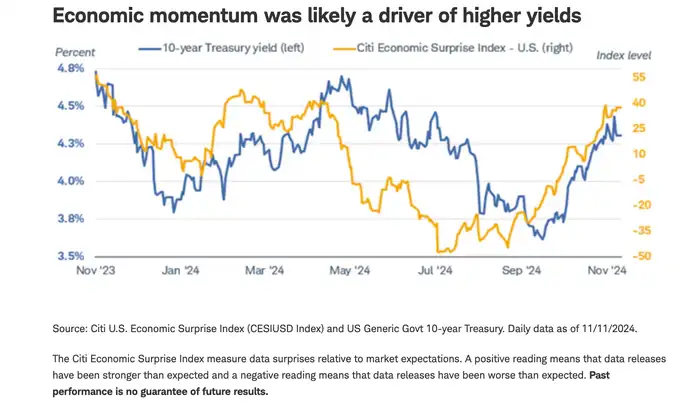4 signs of re-inflation investors should watch out for, Charles Schwab says

The Fed’s mission to lower consumer prices could soon face some snags — and there are a handful of signs investors should be watching out for to determine if prices are on the rise again, according to Charles Schwab.
Strategists at the brokerage firm expect a “choppy” downward path for inflation, despite the fact that overall inflation in the US is cooling. In a new research note, the firm cited a number of pressures in the economy that could buck the disinflation trend and send prices back higher.
“We think inflation will continue to trend lower, but there are a few potential risks on the horizon, including Federal Reserve interest rate cuts, stronger-than-expected economic growth in recent months, and policy proposals by incoming US President Donald Trump,” strategists wrote, pointing to the president-elect’s plan to levy tariffs on US imports, cut taxes, and potentially lower the supply of labor by restricting immigration.
“Tariffs tend to act as a one-time price increase as the costs are passed from importing companies to consumers. Similarly, tax cuts have been proposed that could provide more stimulus to an economy already growing at a healthy pace. Immigration reform could mean higher labor costs,” the note added.
Trump has pushed back on the notion that his economic plan is inflationary, and said he would lower prices for Americans during his second term. He levied tariffs during his first term as president without a significant inflation surge, but experts say the tariffs Trump would impose this time around are far more wide-sweeping, explaining the difference in inflation forecasts.
Meanwhile, the Fed may already be facing some resistance in its goal to get inflation back down to 2%. Prices rose 2.6% year-per-year in October, in-line with what economists had expected, but hotter than the prior month’s 2.4% increase, according to the Bureau of Labor Statistics.
“Looking forward, though, it’s worth assessing potential risks to disinflation,” Schwab added.
Strategists flagged four things in markets that could signal if inflationary pressures in the economy are picking up:
1. Labor costs rising
Labor costs have accelerated in recent months, with unit labor costs among all workers in the business sector rising to 3.4% year-over-year in the third quarter, according to Federal Reserve data.

Unit labor costs picked up 3.4% year-per-year in the third quarter
Higher wages are considered inflationary, as they raise costs for businesses and could lead firms to hike prices, a dynamic known as a wage-price spiral.
“It’s too soon to say whether that uptrend will continue, but if labor supply is restricted and ends up putting upward pressure on wages, faster unit labor cost growth could unleash further momentum in inflation,” Schwab strategists said.
2. The relationship between stocks and bonds
Stocks typically move opposite to bond yields, as higher interest rate expectations priced into the bond market would be bearish for equity prices.
The rolling 120-day correlation between the S&P 500 and the yield on the benchmark 10-year US Treasury has ticked into positive territory, which means stocks and yields are rising in tandem due to expectations of strong economic growth.
If the correlation moves back into negative territory, that could signal greater concern over inflation in the economy, strategists said.

The correlation between the S&P 500 and 10-year US Treasury yield ticked into positive territory.
“If the correlation flips back into negative territory, though, that would be consistent with inflation (again) being the main driver of downside risk for stocks,” the firm wrote. “It’s too soon to say that will be the case, but the risk is worth monitoring as we start to turn the corner into 2025.”
3. Rising Treasury yields
Yields have been climbing ever since Trump secured his second-term in office, with the 10-year yield surpassing 4.4% the day after the vote, its highest level since early July.

The 10-year US Treasury yield briefly surpassed 4.4% after the vote, its highest level in about 4 months.
The increase is reflective of higher interest-rate expectations in the market, a sign that investors are concerned about future inflationary pressures.
“Concerns about a rebound in inflation on the back of stronger-than-expected economic growth since September, and the potential for expansive fiscal policy are the major drivers. Markets are beginning to dial back expectations for further rate cuts in response to inflation concerns,” Schwab strategists said.
4. Economic momentum is building.
The economy looks to be growing stronger than investors expected — another factor that could fuel inflation. The Citi Economic Surprise Index has soared in recent months, climbing from a level of around -50 this summer to 40 as of November.

The economy has performed stronger than expected in recent months, explaining the climb in Treasury yields.
“Stronger growth suggests that the Fed may not lower short-term rates as much as anticipated just a few months ago. Adding to the shift in the view of Fed rate path is the likelihood of higher inflation under proposed policies from the incoming administration,” strategists said.
“We expect the Federal Reserve to continue with rate cuts over the next few months if inflation continues to trend lower. However, we are assuming a slower and shallower path of rate cuts in 2025 than we did just a month ago,” they continued.
Expectations for Fed rate cuts have pulled back in recent weeks as traders digest Trump’s election victory and ready for a new chapter in the economic narrative. The odds that the Fed will pause its rate-cutting cycle in December rising to 42%, up from 14% odds priced in a month ago, according to the CME FedWatch tool.






